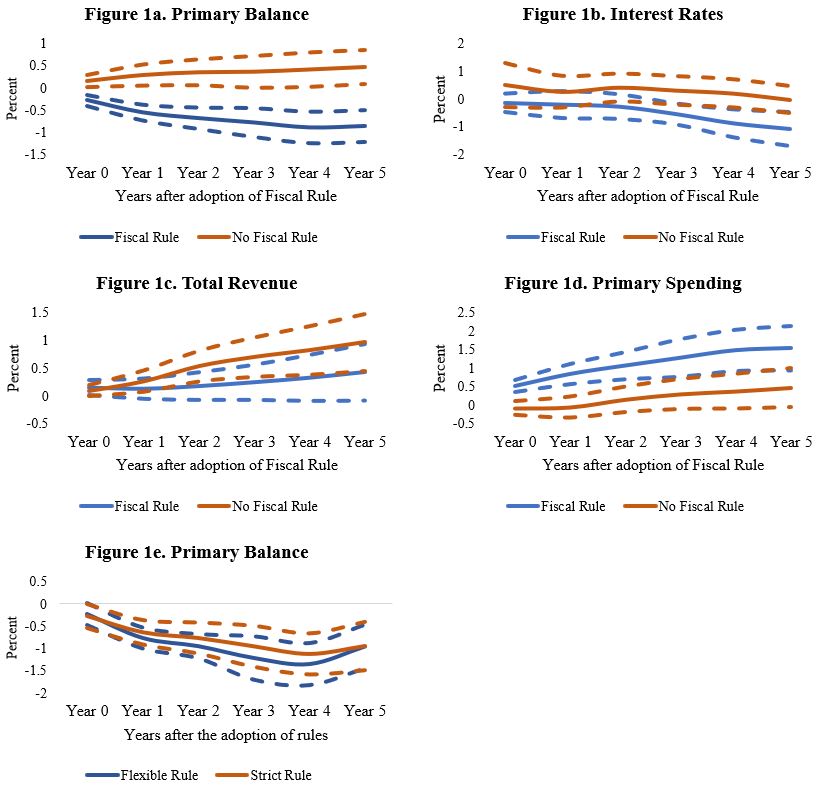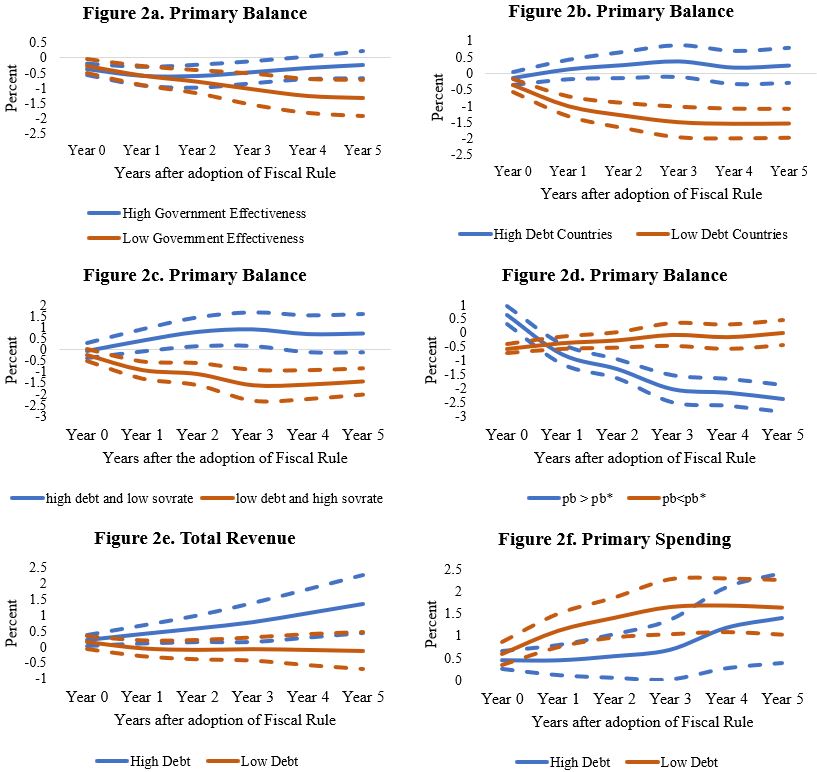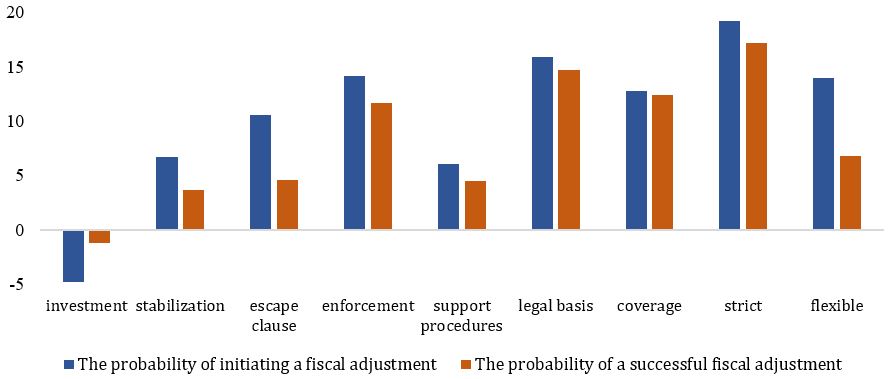

Authors’ note: The views expressed in this column reflect the views of the authors and not necessarily the views of the Bank of Greece, the Hellenic Parliamentary Budget Office and Alpha Bank.
In the post-pandemic era, many countries are planning to tighten fiscal policy in order to correct their fiscal positions. In this context, governments are expected to re-activate fiscal rules. This column examines whether fiscal rules can contribute to fiscal consolidation. The findings suggest that this is true in countries with fiscal imbalances and low credit rating. However, an important role is played by the specific design features of fiscal rules, namely whether they are characterized as flexible or strict. On the one hand, particularly rigid rules can lead to fiscal policy pro-cyclicality and could delay economic recovery. On the other hand, particularly flexible rules with various exceptions may not contribute to fiscal consolidation and public debt sustainability.
In response to the COVID-19 pandemic, the energy crisis and rising inflation, all countries around the globe have implemented numerous fiscal support measures to sustain economic activity and to boost economic recovery. However, this extraordinary fiscal expansion has led to the accumulation of public debt and consequently government debt ratios have reached unprecedented levels. Therefore, in the post-pandemic era many countries are planning to tighten fiscal policy in order to correct their fiscal positions. In this context, governments are expected to re-activate fiscal rules.
However, there are concerns that a strict application of fiscal rules could lead to excess fiscal tightening delaying economic recovery (see Darvas et al., 2018; D’Amico et al., 2021). Several studies have shown that the EU fiscal rules have both failed to ensure debt sustainability and reduce fiscal procyclicality in the run up to the 2008-2009 global financial crisis (see e.g., De Jong and Gilbert, 2020; Gootjes and de Haan, 2022a) and that fiscal policy has been expansionary in good times and contractionary in bad times (see e.g., Fritsche et al., 2021; McManus et al., 2021) failing to stabilize economic activity. However, another strand of the literature has shown that fiscal rules, promote sound fiscal policies (De Jong and Gilbert, 2020, Gootjes and de Haan, 2022a). Building on the existing literature (see e.g., Caselli et al., 2022), we examine in two closely related papers (Chrysanthakopoulos and Tagkalakis, 2023, 2024) whether or not, the introduction of fiscal rules contributes to fiscal consolidation and promotes fiscal discipline.
Examining a group of 86 advanced and emerging market economies we find (Chrysanthakopoulos and Tagkalakis, 2024) that the adoption of a fiscal rule (and in particular, an expenditure rule, a budget balance rule or a debt rule) is associated with smaller primary balances in the medium-term relative to a case where there is no fiscal rule in place (see Figure 1a). This occurs because the introduction of a fiscal rule improves policy credibility, leading to lower long-term interest rates (see Figure1b). The decline in primary balance after the adoption of a fiscal rule is due to significantly slower revenue growth and higher primary expenditure growth than in countries without a fiscal rule (see Figure 1c and 1d). Moreover, we find (see Figure 1e) that fiscal rules with more flexible design features (i.e., fiscal rules which have at least one of the following characteristics: a cyclically adjusted budget balance target, they exclude public investment from their target and provide for an escape clause) induce a larger reduction in the primary balance over the medium-term relative to those with stricter design features (i.e., fiscal rules which have at least two out of the following four characteristics: strong enforcement, extensive coverage, high legal basis and multi-annual spending limits).
Figure 1: The medium-term effect of fiscal policy rules – baseline model

Notes: Figure 1 reports the cumulative effect on the variable of interest of adopting a fiscal rule. The error bands correspond to 90% confidence intervals.
However, fiscal rules are not always associated with lower primary balances. In more detail, the adoption of fiscal rules leads to a prudent fiscal policy stance in the medium-term, contrary to the baseline specification, in countries with high government effectiveness (Figure 2a), high public debt ratio (Figure 2b) and low sovereign debt rating (Figure 2c), insufficient fiscal effort to bring down the debt ratio (Figure 2d), positive interest-growth rate differential, and with a low tax revenue-to-debt ratio. Note, that the introduction of a fiscal rule leads to a faster increase in public revenue and a slower increase in primary expenditure in high debt relative to low debt countries (see Figures 2e, 2f).
Figure 2: The medium-term effect of fiscal policy rules -robustness checks

Notes: Figure 2 reports the cumulative effect on the variable of interest of adopting a fiscal rule. The error bands correspond to 90% confidence intervals.
Turning to the individual fiscal rule characteristics, we obtain a similar response profile (as with the overall fiscal rule index) for the primary balance in high- and low-debt countries when we examine the fiscal rules that are characterized as strict, i.e., those that have high coverage, high legal basis and are characterized by strict enforcement. On the contrary, in the case of flexible fiscal rules or fiscal rules that have multi-annual spending limits, an escape clause and a cyclically adjusted primary balance target, the primary balance response is negative over the forecast horizon in both high- and low-debt countries (see Figures 3a, 3b). Hence, the presence of strict fiscal rules is a prerequisite in high-debt countries for them to run primary surpluses over the medium term and to address public debt sustainability concerns (as in De Jong and Gilbert, 2020). In low-debt countries, both flexible and strict fiscal rules reduce the primary balance over the medium-term.
Figure 3: The medium-term effect of fiscal policy rules- flexible vs strict characteristics in high and low public debt countries

Notes: Figure reports the cumulative effect on the primary balance of adopting a fiscal rule. The error bands correspond to 90% confidence intervals.
In a closely related paper (Chrysanthakopoulos and Tagkalakis, 2023) using a panel of 40 advanced economies from 1990 to 2020 and the IMF dataset on fiscal rules developed by Davoodi et al. (2022) and building on earlier studies (see e.g., Wiese et., 2018; Ziogas and Panagiotidis, 2021; Gootjes and de Haan, 2022b; Afonso et al., 2022), we investigate the effect of the individual characteristics of fiscal rules on the probability to initiate a fiscal adjustment, as well as on the probability that this fiscal adjustment will be successful. We find that a fiscal rule that includes a budget balance target in cyclically adjusted terms, has a well specified escape clause, involves strict enforcement, strong legal base, applies to the general government and has multi-year spending ceilings increases the probability of initiating a fiscal consolidation. Remarkably, we find that the positive effect of strict fiscal rules’ characteristics on the probability of fiscal adjustment is more sizeable relative to that of flexible rules’ characteristics (Figure 4, blue bars). Turning to the probability of successfully concluding a fiscal adjustment, we find that a fiscal rule that includes a budget balance target in cyclically adjusted terms, has a well specified escape clause, involves strict enforcement, has a strong legal base, and applies to the general government increases the probability of a successful fiscal adjustment (Figure 4, orange bars). Although both strict and flexible features are contributing to successful fiscal consolidation, the effect of strict fiscal rules design features is quite more sizable compared to the one of flexible fiscal rules.
Figure 4: The probability of starting and successfully concluding a fiscal adjustment

Notes: This figure shows the marginal effect of the design features of fiscal rules on the probability of starting and successfully concluding a fiscal adjustment.
Our two recent papers lead us to the conclusion that fiscal rules can contribute to fiscal consolidation in cases where there are fiscal imbalances. However, we find that it is mostly the expenditure rules, the debt rules, and the balanced budget rules that help with this rather than the revenue rules. At the same time, we find that the special features of the fiscal rules should be taken into account. While the flexible features of fiscal rules are seen as necessary to prevent an excessive fiscal tightening in recessionary periods (Ardanaz et al., 2021)), our findings show that the stricter features of fiscal rules lead to an increase in the primary balance in the medium term in countries with high debt and at the same time contribute more to the success of a fiscal adjustment.
Hence, there is obviously a trade-off between strict and flexible rules which should be further explored. On the one hand, particularly rigid rules can lead to fiscal policy pro-cyclicality and could delay economic recovery. On the other hand, particularly flexible rules with various exceptions may not contribute to fiscal consolidation and public debt sustainability.
Afonso, A., Huart, F., Jalles, J. T., & Stanek, P. (2022). Twin Deficits Revisited: a role for fiscal institutions? Journal of International Money and Finance, 121, 102506.
Ardanaz, M., Cavallo, E., Izquierdo, A., & Puig, J. (2021). Growth-friendly fiscal rules? Safeguarding public investment from budget cuts through fiscal rule design. Journal of International Money and Finance, 111, 102319.
Caselli, F., Davoodi, H., Goncalves, C., Hee Hong, G., Lagerborg, A., Medas, P., Nguyen, A., and Yoo, J. (2022), “The Return to Fiscal Rules,” IMF Staff Discussion Notes, 2022 (002).
Chrysanthakopoulos, C., & Tagkalakis, A. (2024). The medium-term effects of fiscal policy rules. Journal of International Money and Finance, 103019.
Chrysanthakopoulos, C., & Tagkalakis, A. (2023). The effects of fiscal institutions on fiscal adjustment. Journal of International Money and Finance, 134, 102853.
D’ Amico L., Giavazzi, F., Guerrieri, V., Lorenzoni, G., & Weymuller, C. (2021). Revising the European Fiscal Framework. URL: https://voxeu.org/article/revising-european-fiscal-framework-part-1-rules (accessed: 14.01.2022).
Darvas, Z., Martin, P., & Ragot, X. (2018). European fiscal rules require a major overhaul. Notes du conseil danalyse economique, 47(2), 1-12.
Davoodi, H. R., Elger, P., Fotiou, A., Garcia-Macia, D., Han, X., Lagerborg, A., Lam, R., & Medas, P. (2022). Fiscal Rules and Fiscal Councils. IMF Working Paper WP 22/11.
De Jong, J. F., & Gilbert, N. D. (2020). Fiscal discipline in EMU? Testing the effectiveness of the Excessive Deficit Procedure. European Journal of Political Economy, 61, 101822.
Fritsche, J. P., Klein, M., & Rieth, M. (2021). Government spending multipliers in (un) certain times. Journal of Public Economics, 203, 104513.
Gootjes, B., & de Haan, J. (2022a). Procyclicality of fiscal policy in European Union countries. Journal of International Money and Finance, 102276.
Gootjes, B., & de Haan, J. (2022b). Do fiscal rules need budget transparency to be effective?. European Journal of political economy, 75, 102210.
McManus, R., Gulcin Ozkan, F. and Trzeciakiewicz, D. (2021), Why are Fiscal Multipliers Asymmetric? The Role of Credit Constraints. Economica, 88: 32-69
Wiese, R., Jong-A-Pin, R., & de Haan, J. (2018). Can successful fiscal adjustments only be achieved by spending cuts? European Journal of Political Economy, 54, 145-166.
Ziogas, T., & Panagiotidis, T. (2021). Revisiting the political economy of fiscal adjustments. Journal of International Money and Finance, 111, 102312.